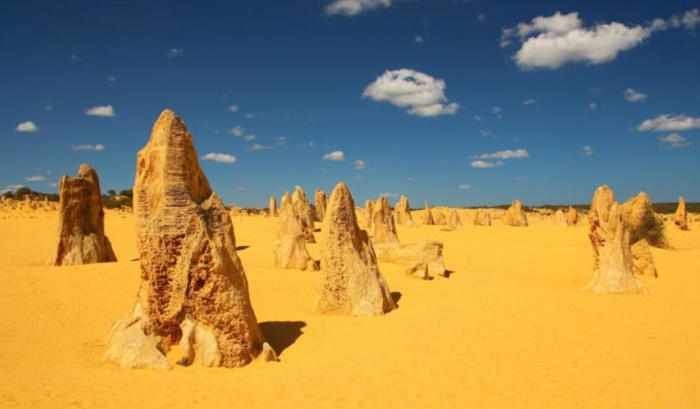The Pinnacles |

Pinnacles Desert - Nambung National Park
The Pinnacles are amazing natural limestone structures, formed approximately 25,000 to 30,000 years ago after the sea receded and left deposits of sea shells.
Drive or wander through the mysterious, otherworldly desert and soak up views of the Pinnacles and yellow earth.
Look back towards the coast to see how the landscape changes from the yellow of the desert, to white sand dunes, and the blue of the Indian Ocean in the background.
Don't forget to keep your eyes peeled for native Australian wildlife like kangaroos and emus, particularly if you are visiting early in the morning or later in the afternoon.
Located at the southern gateway to Australia's Coral Coast, along the Indian Ocean Drive, the Pinnacles Desert of Nambung National Park is one of the major natural attractions in the region and are Western Australia's most visited attractions.
The park is located roughly 200km, or 2 hours' drive north of Perth, and covers an area of 17,487 hectares providing natural habitat for an extensive array of native animals and bird life.
The Pinnacles are amazing natural limestone structures, formed approximately 25,000 to 30,000 years ago after the sea receded and left deposits of sea shells. Over time, coastal winds removed the surrounding sand, leaving the pillars exposed to the elements. The Pinnacles range in height and dimension - some stand as high as 3.5m!

Western Australia's mysterious desert Pinnacles formed 100,000 years ago: study
Story by environment reporter Peter de Kruijff | msn.com
To stand among the limestone spires and shifting deep yellow sands of the Pinnacles Desert can feel like being on another planet.
Yued people from the region, which they call "Kwong-kan" (sandy place), say the rocks represent the fingers and hands of warriors who were swallowed by the desert for disobeying their elders and venturing into a taboo area.
Western science has long debated why and when the "Pinnacles" formed, with estimates ranging anywhere from 25,000 to more than 200,000 years ago.
Now a new study, published in the journal Science Advances, suggests most of the towering geological features were shaped 100,000 years ago into the pillars we see today, which can be up to 5 metres high and 2m wide.
The Pinnacles are leftovers from a much large block of limestone that dissolved over time, study lead author Matej Lipar, from the Slovenian Academy of Sciences and Arts, said.
His co-author, Curtin University geologist Milo Barham, likened the rock to "Swiss cheese" where the holes got so big all that was left was the Pinnacles.
The key challenge for the researchers, Dr Barham said, was how to study something that was removed.
"How do you date the disappearance of something?"
Iron nodules provide dates
The Pinnacles are around two hours' drive north of Perth on the world's longest belt of coastal limestone, which stretches some 1,000 kilometres from Shark Bay in the north west nearly all the way to Albany in the south.
The big belt is known as the Tamala Limestone, and it was laid down over 2 million years ago.
Limestone, made from shells and sand washed ashore in ancient times, is particularly susceptible to weathering and dissolves easily when exposed to chemicals such as carbonic acid, which can be present in rain.
The remaining landscape is known as karst, a term used for areas comprising weathered limestone or other minerals such as gypsum and dolomite.
To pin down when the Pinnacles formed, the researchers looked at other geochemical processes that took place as the limestone dissolved.
"What a lot of people in WA would be familiar with is the red of the landscapes, and that's to do with the iron in the rock," Dr Barham said.
While the limestone in the area dissolved, nodules containing iron-rich minerals formed on the Pinnacles themselves, Dr Lipar said.
"[The iron nodules are] really small, so most people don't even notice they're there," he said.
The researchers calculated the age of the iron nodules using a method called U-Th/He dating, which measures the accumulation of helium atoms produced by the radioactive decay of uranium and thorium.
From this, the researchers concluded an extremely wet period lasting a few thousand years occurred about 102,000 years ago and dissolved the limestone, forming the Pinnacles.
While most of the pillars at the Pinnacles are joined at the base, there are also several which appear to have formed by a different process, where sand filled dissolved holes.
Mysteries remain
While scientists may have a better understanding of when the Pinnacles formed, exactly why each spire survived when the rest of the limestone dissolved is hard to ascertain.
Dr Barham said he thought, in some instances, spire formation might be due to random chance, depending on where holes in the limestone initially formed.
"Or was there some sort of structure above that was protecting fluid ingress into that piece of limestone?" he said.
"These are some of the things that I guess we still need to find out. There's plenty of mystery left in the Pinnacles to explore."
Looking further afield, Dr Lipar said if iron nodules are present in similar karst regions around the world, they too could be used to date those areas and gain a deeper understanding of Earth's past climates.
"There's regions like the Caribbean, also the Mediterranean islands and coastline ... and South Australia, [where] everything is made of similar rock," he said.
Getting Here
The Pinnacles are found in Nambung National Park, approximately 200 kilometres north of Perth, Western Australia.
The Pinnacles are 2 hours' drive north of Perth.
Self-drive north along Wanneroo Road which turns into Indian Ocean Drive, and turn right at the sign for the Pinnacles.
Self-drive north along the Brand Highway and turn left at the sign to Cervantes; from Cervantes, drive south for 2km to the Nambung National Park Boundary and continue a further 14km to the Pinnacles car park.
How do I get to the Pinnacles?
From Perth drive north along Wanneroo Road, which will turn into Indian Ocean Drive, and turn right at the sign for the Pinnacles. Alternatively, from Perth drive north along Brand Highway and turn left at the sign to Cervantes; from Cervantes, head south two kilometres and turn left at the sign for the Pinnacles. The drive time is approximately 2 hours.
Do I need a four-wheel drive to access the Pinnacles?
Not at all! Nambung National Park and the Pinnacles are both accessible by two-wheel drive.
Do I have to pay to visit the Pinnacles?
There is a National Park Entry Fee to Nambung National Park, which contributes to park management, protection of the environment, and the development and maintenance of visitor services and facilities. This fee is $15.00 per private vehicle, carrying up to 12 occupants. For more information about National Park Entry Fees click here.
When can I visit the Pinnacles?
You can visit Nambung National Park and the Pinnacles Desert at any time, however visitors are expected to have left the park by 9pm.
❊ Address ❊
⊜ Nambung National Park Nambung View Map
❊ More Information ❊
→
www.visitpinnaclescountry.com.au
Update Page







